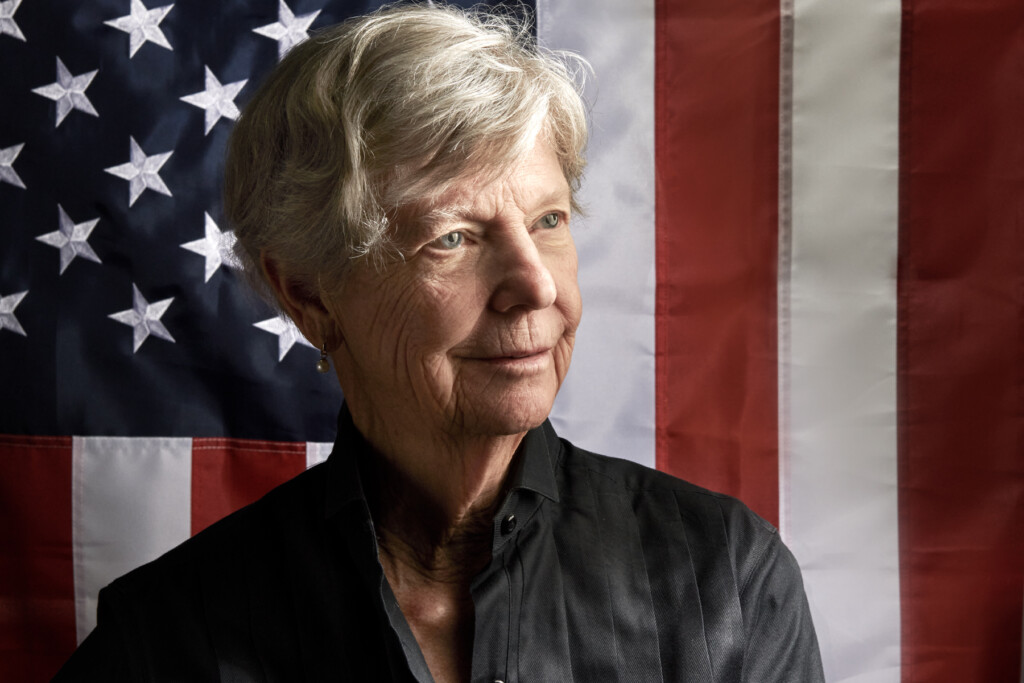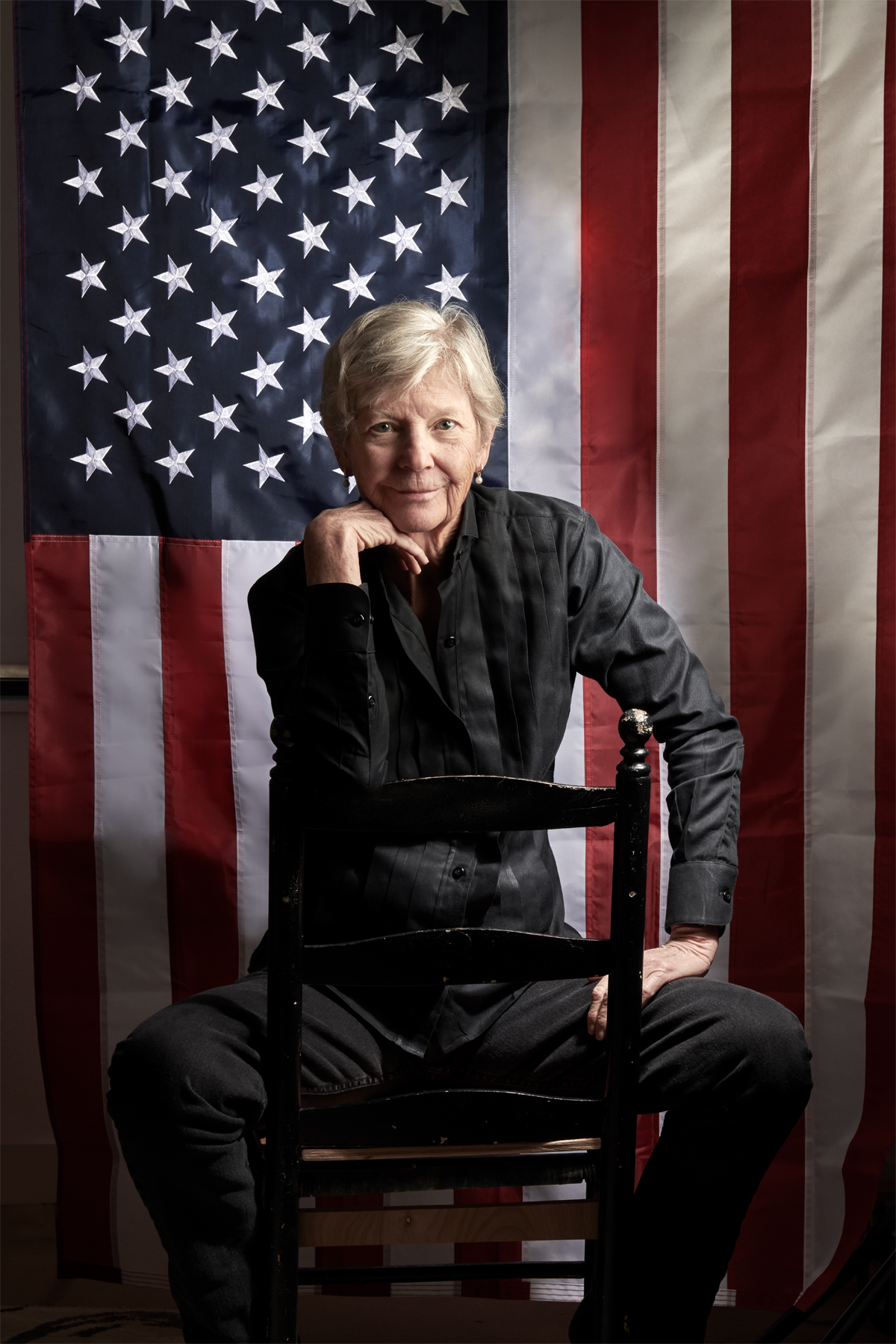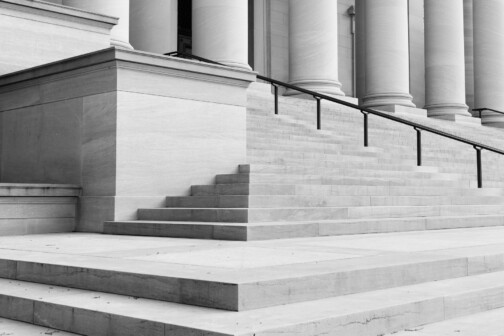There’s a place in Mesquite where the streets have names such as Santiago, Trinidad, Caribbean, and Caracas. Despite the global flair, the homes are modest, mostly built in the 1950s. The farther north and west you go, the bigger they get. Kathleen Cordelia Bailey built hers in 2019, near where the streets dead-end on the edge of the Dallas Athletic Club. It’s midcentury modern in style, gray and stark from the front. The exterior, shielded by a low concrete wall, is almost bunkerlike, with a single long, narrow opening just under the roofline. Inside, it is bright and airy, filled with Bailey’s oil paintings and photographs. From the glass dining room table, she and her two cats can watch birds feed in an interior courtyard. “I want a fortress open to the sky,” she had told her architect, and that it is.
The 74-year-old Bailey is small and slender, her hair short and neat. She’s dressed in a sharply pressed black-and-white-striped Oxford. She has invited me to her home to talk about her new self-published short story collection, titled Moments. Half fiction, half nonfiction, it covers everything from imagined affairs to her actual loss to Lance Gooden when she ran for Congress in 2022, a defeat that was perhaps due in small part to the redrawing of the 5th District—after she announced her campaign—to exclude her very specific triangle of mostly globally named Mesquite streets.
Sitting at her dining room table, I tell her my issue with her short story collection is that she has left out the best parts. She has ignored most of her career, certainly the bits about predicting the Iranian Revolution and unmasking a worldwide Soviet disinformation campaign, managing to piss off both Mikhail Gorbachev and Secretary of State George Shultz in the process. She should be the female Tom Clancy.
She tells me she dislikes Clancy and couldn’t get past the second page of Hillary Clinton’s novel. She doesn’t want to read that kind of stuff. “It’s too close.”
For her, it’s not about gripping plotlines. What she’s interested in are people’s motivations—why they do what they do. “The plot is just kind of the tree,” she says. “All of the rest that really interests me is the leaves.”
Her dad was a roughneck on the oil patch. He went to night school at SMU and worked his way up to become an engineer, “you know, a pencil pusher,” because he loved the refining end as opposed to the oil field end. “Have you eaten at the Mansion on Turtle Creek?” He worked out of that building, where American Petrofina had its headquarters. His office was at the top of the grand staircase, and she can remember, as a little girl, running up one set of steps and across the hall to the other to run back down, around and around and around.
When she was 9, her dad was promoted to manage a refinery in Memphis. When she was 10, she had her first kiss.
From Elvis.
Her family had moved into a modest brick ranch house on Old Hickory Lane, next door to Graceland. She hopped the low brick wall that separated them once but was stopped by a guard and his dogs. So she took to waiting by the front gate after school with the ever-changing multitude of fans. One day, while she was alone, a car came down the drive, and Elvis got out. He told her to put her lips against the crosshatch mesh of the gate if she wanted a kiss. “His lips felt very warm and exceedingly wet.”
Next came a return to Dallas and then a move to Pana, Illinois, a little town in the middle of nowhere. Her dad had cobbled together the financing to purchase a small, mothballed refinery. He was finally his own boss, but now, in addition to competing with the major oil companies, he found himself dealing directly with labor unions. There were threats of small accidents with huge consequences and meetings with guns and paper bags full of money.
Late one night, there was an anonymous call about a fire. Kathleen’s mother and siblings were out of town, so her father put her in the car, and they sped to the refinery. He told her to wait while he ran in to try to shut off the valves before the whole place blew. Terrified for her father, she got out of the car to watch. “I was shocked to see that the flowing creek coming toward me was ablaze.”
Her father managed to save the refinery from being a total loss, but the independent venture was over. He took a job in New Jersey, and Kathleen stayed to attend college at the University of Illinois at Urbana-Champaign.
In high school, she wanted to become a theologian, to understand what drives people’s lives from the inside. She read Ayn Rand and Carl Jung’s Memories, Dreams, Reflections from her mother’s bookshelf. She realized influential thinkers all seem to have a take on ethics and religion. She thought, Let me pull the string and see where it goes.
She studied the context of religions, how each one evolved from a specific societal need. How religious wars tend to tear apart the lives of the common man without having much of an impact on kings and queens, except maybe the wives of Henry VIII. She fell out of love with the double-edged sword of religion, which generally forbids killing yet often condones it for a subjective greater good. Instead, she focused on the origins of religion and their impact on political science and how people behave.
That’s how she predicted the Iranian Revolution.

Her Ph.D. dissertation was on the National Iranian Oil Company. She spent a year in Iran in the early ’70s, near the end of Mohammad Reza Shah’s reign. No one knew it was near the end, except for her, because she lived on the edge of the university. She could feel it. She could feel that the country was about to blow, just as her father had felt the refinery was about to blow as she watched the creek fill with flames. So when she came back to the States to start her first job as the first social scientist ever hired at the Lawrence Livermore National Laboratory in California, and had to try to make herself useful while sitting at a desk waiting for her security clearance to come through, she wrote a paper about why and when and how an Iranian revolution was going to happen.
Because the shah wouldn’t let any opposing parties gain traction, she theorized, the only organizational leaders strong enough to execute a revolution were the clergy. They were structured and hierarchical. They had mosques. They had a message. Her paper quickly circulated throughout the U.S. Intelligence Community, including the CIA. They stamped it SECRET even though it only contained opinions based on the personal observations of a recent Ph.D. candidate. But they told her it would undermine the shah’s regime if it got out that a U.S. government official had written a paper saying a revolution was imminent.
For years after, people would come up to her in the Pentagon and ask her how she managed to nail it. “I went over there and lived,” she told them. “That’s what you have to do. You have to know the other person and how they’re thinking. It’s the same way with life. If you want to know what your opponent is going to do, go live with them.”
She met her second husband, Robert Barker, at Livermore. Her job was to analyze intelligence on countries pursuing weapons of mass destruction. Barker, who had his Ph.D. in theoretical physics, was conducting a technical intelligence analysis of the former Soviet Union’s nuclear weapons program. So they had things to talk about.
In 1983, six years after meeting, they got married in Minden, Nevada. At one time, Minden was the vacation destination of Clark Gable and Jean Harlow, but Bailey and Barker didn’t pick it for that reason. They didn’t need a marriage license in Nevada, it was an easy drive from San Francisco, and they had both been hired by the Reagan administration, which had a rule that you had to be married to live together or you couldn’t get promoted. “Morality and ethics and everything was so much more weird than it is now,” she says, laughing. “People don’t know it. I know it.”
Remember the Downton Abbey meme “What is a weekend?” That was Bailey’s life at Livermore. She got up, went to work, came home, and went to bed. She doesn’t remember eating or doing anything else. It was a job that consumed her. She was doing things like taking away Taiwan’s ability to have nuclear weapons. She never really second-guessed it, except, maybe, now.
Would we be having this tense standoff today with China over Taiwan if Taiwan had its own nuclear weapons capability, like Pakistan does? Would Russia have invaded and annexed Crimea in 2014 and then invaded Ukraine again in 2022 if it had nuclear weapons? Sitting at her kitchen table with Paco—her long-haired cat who recently had a full-body shave to keep him from choking on his own hairballs—she looks back and wonders, Is that what I worked so hard for? Was it right?
It’s complex stuff.
“When you’re young, everything is black and white,” she says. “And we are old. Everything is gray, literally and figuratively.”
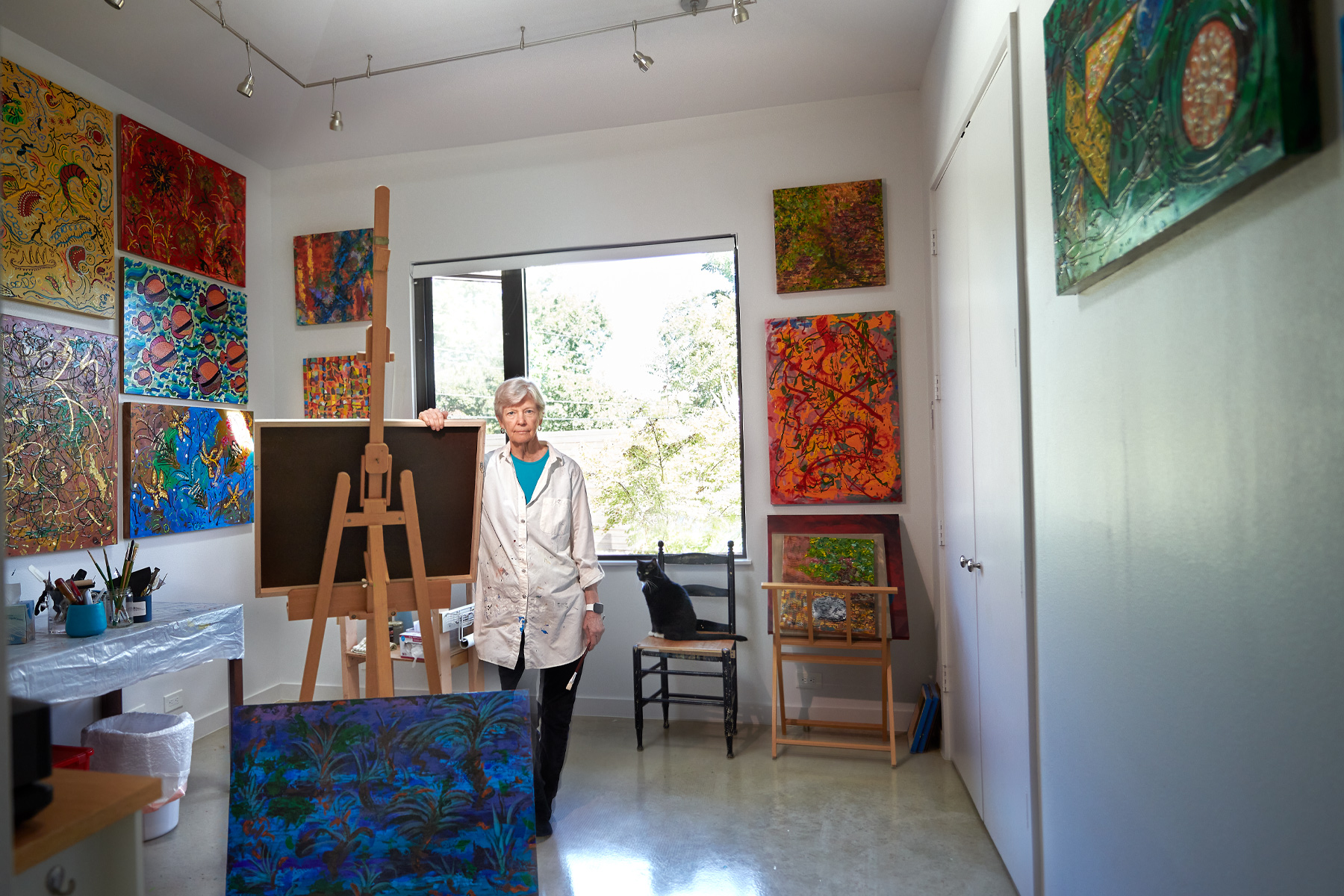
After working at Livermore for more than a decade, she went to Washington, D.C., where the Reagan administration appointed her as deputy director for the Bureau for Research in the U.S. Information Agency. Later she served during the end of the Cold War as a deputy assistant secretary in the Bureau of Intelligence and Research in the U.S. Department of State. She oversaw a portfolio on active measures, meaning covert political operations by foreign governments ranging from disinformation campaigns to staged insurrections. She pissed off Mikhail Gorbachev at least twice. Secretary of State George Shultz wasn’t too happy with her either.
At the time, the former Soviet Union had an organization staffed with about 15,000 people solely dedicated to disinformation campaigns. Combating stories that were placed worldwide in Soviet-controlled newsrooms was like a game of Whac-A-Mole. There was the one about how the United States was adopting babies from Latin America and using them for parts to save American babies. It was a very effective story. But that’s not the one that really got to her.
The story that got to her was the one that the United States created AIDS as a biological weapon. The message in Africa was that it was tailored to kill Black people. The message in Latin America was that it was tailored to kill Brown people. The message in Chicago was that it was tailored to kill the Black Panthers.
“Usually I was driven to work from a commitment to—and a belief in—doing the right thing,” Bailey says. “But that one made me driven by anger. So many of my friends and people I knew were dying from AIDS. And I decided that I was going to find out if it was at all possible that the virus really was created by the United States. Because I didn’t believe it, but I didn’t know.”
Here’s the thing: the U.S. government was bound by law to not use disinformation except in the case of war. Say, Operation Bodyguard in WWII, which was intended to mislead the German High Command about the actual location of the Normandy landing. So for Bailey, the best and only way to counter the lies was with the truth.
She headed to Fort Detrick in Maryland, which once housed the U.S. biological weapons program but now housed the biological defense program. She met with doctors and researchers and then ran what she found by independent academics. She finally felt sufficiently armed for battle. “We met and decided as an interagency group that the best way to counter it was just by exposing it,” she says. “Don’t argue. Don’t fight. Expose.”
She put a cartoon from Pravda on the cover of the final report that proved AIDS was not a biological weapon. It was of a scientist handing a vial of swastika-shaped viruses to a military man who was handing the scientist U.S. dollars in return. She gave a public briefing on C-SPAN. The American press didn’t pay much attention, but the foreign press did.
Gorbachev paid attention. He took a copy of the report, annotated in his own handwriting, and shook it in Shultz’s face, accusing him of trying to tank their developing detente. The secretary of state was angry that his efforts to conduct diplomacy on an informal, private basis were being stymied. “Shultz came back and ordered my boss to terminate my group,” Bailey says. “I didn’t quit holding the group meetings. I just hoped nobody would notice.”
In the end, the entire disinformation effort was moved out of the State Department and effectively deep-sixed. Bailey moved laterally to an assistant director job at the Arms Control and Disarmament Agency in the same building. She was now responsible for weapons nonproliferation efforts, including nuclear, chemical, and biological.
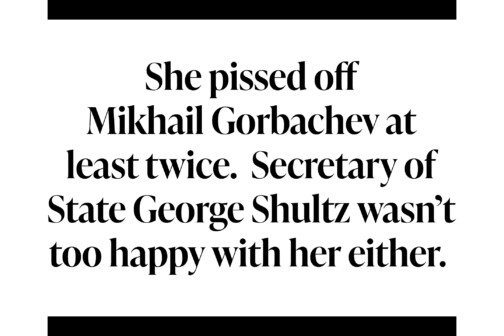
She caused her own firestorm testifying before Congress about why the Chemical Weapons Convention wasn’t in the national security interest. She wasn’t opposed to banning chemical weapons per se; she just thought the treaty was no good. “If you can’t verify zero, why go spend hundreds of millions of dollars?” That was point No. 1. No. 2, the chemicals all had multiple uses. If you can use them for good, they can’t be completely banned. And how are you going to confirm how the stockpiles are actually being used?
Next came the Comprehensive Test-Ban Treaty. That one didn’t define nuclear tests clearly enough to encompass what the Soviet Union was doing. So why sign a treaty that would be more onerous for us than it would be for the Soviets or the Chinese or any other state?
“My arguments made a lot of sense,” she says. “I had people from both sides of the aisle listening to them. Frankly, I believe that I was a large contributor to why the Comprehensive Test-Ban Treaty was not ratified by the United States.”
Regardless, by the time Bill Clinton became president, her opposition to the treaties had led her to be ostracized by the secretary of energy, among others. When she was subsequently denied a promotion, she sued for retaliation and gender discrimination because all of the other applicants were male and none of them were as qualified. She settled the case, and she retired from government service in 1999 at the age of 50. She and Barker moved to Hawaii to become lime farmers.
They had 140 lime trees on 4 acres in Kaua’ i. They raised hens for eggs and grew vegetables for the food bank. She learned what it was like to worry about whether or not it was going to rain or whether it was going to rain too much and whether the bugs were going to eat everything because everything was organic and no chemicals were allowed. “It was 13 wonderful years doing something totally different,” she says.
When Barker died, in 2012, she cratered. She couldn’t stay in Hawaii. Everywhere she looked was a memory. She had family here, so she came home to Dallas. She knew this town. She had been born here. “I’m going to stay probably to the end.”
She painted. She took photography lessons online and self-published a book. She made a small-budget movie, Revenge in Kind, about a woman who is not the victim but the serial killer. And she started writing short stories.

“It was a choice,” she says, “between drinking myself to death or getting up out of bed in the morning and trying to do something.”
While we are sitting and chatting at her dining table in March, the 20th anniversary of the Iraq War is on the news in the background. I ask her about her take on all of that, even though weapons of mass destruction were never under her purview.
“I do want to make a comment about that,” she says. “You know, weapons of mass destruction are defined as nuclear, chemical, and biological: all three. Saddam Hussein had chemical weapons. He used them against his own people in Halabja; there are pictures of it. The United Nations sent a team; they documented it. Chemical weapons were used. There were stockpiles. The United States spent hundreds of millions of dollars decommissioning and destroying those weapons. So did we go in and find weapons of mass destruction? Yes, we did. I’m sorry, but we did.”
She doesn’t like that the press keeps saying there were no WMDs because there were no nuclear weapons. She says that if you go back and review Dick Cheney and Colin Powell’s testimonies, they only ever referred to WMDs and never specified nuclear.
“I asked them, ‘Why didn’t you say, “Yes, there were chemical weapons?” ’ ‘Well, because the public wouldn’t understand.’ Come on, the public understands if you explain it to them. I don’t like looking down at the public. If you tell the public, they will know and they will understand. That’s what leadership is about, telling and explaining in a way that’s understood.”
When I return to visit Bailey in October, her black cat, Kala, named for the Hindu goddess of doomsday, has just escaped death herself after eating part of a cat-unfriendly houseplant. Bailey, on the other hand, is hard at work making plans for her 75th birthday, which will be in January. She says she’s the only member of her family to have made it that far. The party will be at the Dallas Athletic Club, and she’s working with the chef on a seven-course vegetarian menu—which ranges from panisse squares topped with muhammara to a duo of beet and gingered carrot latkes to a fig-and-date-sweetened Lady Baltimore cake—that she’s designed and tested herself. Along with her movie producer and her niece, her roommate from Tehran, whom she hasn’t seen since 1976, will be in attendance. There will be a DJ playing hits from the ’60s to the ’90s. Bailey, who says she never learned how to dance properly, is taking cha-cha lessons.
A senior associate at the National Institute for Public Policy, Bailey still publishes papers on the Comprehensive Nuclear-Test-Ban Treaty, and democracy in Taiwan, and China’s quest for a new world order. She’s been thinking a lot about overpopulation and Haiti and China’s new sort of colonialism, which, she says, is focused in part on establishing schools for journalists and buying media companies and creating an embedded infrastructure around the globe that could be used just as easily for disinformation as information. She was interviewed, in 2018, for a New York Times opinion video series about disinformation campaigns and the Soviet AIDS hoax that offers creepy insights into lies about election meddling and a subsequent U.S. president-endorsed insurrection that will occur a few short years later in the same chamber where she once answered questions before Congress about national security. But she’s been thrown by my questions about her life.
“Sorry,” she says, finally interrupting me. “Your questions are about me and my past. Are you interested in the reality as opposed to the fiction?”
I am absolutely fascinated by her reality as opposed to her fiction, I tell her, because her reality is a tree full of leaves.
There’s a story from the nonfiction part of her book called “Two Flights.” The first part relates her experiences leaving Cairo in 1985. It is packed full of details: about how she’s late because a herd of camels was stopping traffic; about how, instead of having to pay a bribe to keep her seat, she flashed her diplomatic passport; about how she had to jostle for overhead bin space amid passengers with such carry-ons as a 2-foot-tall samovar; about how, upon liftoff, nearly all the passengers lit their cigarettes in unison.
When the samovar guy goes to light the kerosene in the reservoir to make himself a cup of tea, Bailey has finally had enough. She blurts out to anyone listening, “I’m not the crazy one here! That’s flammable, and people are lighting cigarettes all over this plane! We could explode!”
It’s the kind of brilliant comic interlude that effectively breaks the tension, maybe not in a Tom Clancy book but certainly in an Ian Fleming one. But that’s what I’m missing: the tension of before and after.
I want to know what part of Reagan’s agenda took her to Cairo and what was expected of her when she got home. That’s the same year Egyptian President Hosni Mubarak visited Washington to try to encourage direct negotiations between Israel and a Jordanian-Palestinian delegation. I’m interested in an insider’s take on that history, which, like an 8-year-old Bailey on the Mansion stairs, seems to keep running around and around and around.
I want to know all the bits about what it was like, for most of her career, to be the only woman in the only room where decisions were being made about how to stop Armageddon. When Jack Nicholson shouts his famous line in A Few Good Men—“You can’t handle the truth!”—he is talking about what it takes in terms of brute strength to secure U.S. walls, both literal and figurative. I imagine Bailey shouting the same goosebump-inducing line in a room full of male decision-makers but meaning the opposite: the truth, not its obfuscation, is all that can save us. But Bailey warned me from the start.
That is her problem with reality. It’s just too close.
This story originally appeared in the December issue of D Magazine with the headline “A Quiet Citizen.” Write to [email protected].
Author



